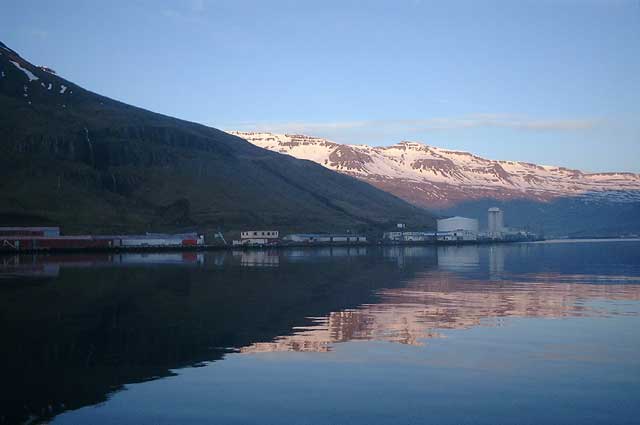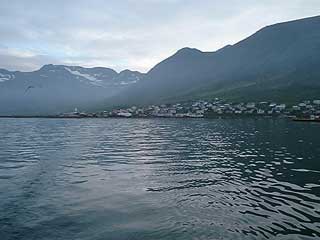
Sunny Iceland
Summer, 2002

Daylight that doesn't end is a really nice thing. Watching the sun go down to the horizon, and come right back up without ever going below the horizon is beautiful. Instead of frequently checking that Orbit's battery has enough charge, the long hours of sunshine mean checking that the solar panels are not overcharging the battery. Being able to enter unfamiliar ports at 0100 easily, because it is broad daylight makes sailing the coast, especially singlehanded, much easier.
It does rain (and snow) here in the summer, and there are storms, but I have so far been fortunate enough to have been in port for all the storms, instead of out at sea. I've also been fortunate that the few minor things that have broken or not worked onboard have all done so in port, where they caused no problems, and were easy to fix. It feels like waiting for the other shoe to drop.
Besides the wonderful long hours of daylight and spectacular scenery, it doesn't get unpleasantly hot here. On land, when the wind is from inland, it doesn't seem to get much above 70F (20C). At sea, it is colder, and often foggy, and one never gets too warm (in fact, it is really cold).

Typical sailing outfit
Motoring through a calm and peaceful sea, twenty miles from Seydisfjordur, Iceland, our intended first port, the wind suddenly found us. We now had a F5 headwind, still increasing, a rising barometer (which usually indicates a decreasing wind), and a concern about what was coming. We had had no weather forecasts for the prior two days of our otherwise-uneventful sail from Scotland. Though the wind was roughly parallel to the coast (therefore not causing a lee shore condition), we had no idea if it might shift, and then we would be in a lee-shore situation (where the wind is blowing the boat towards the shore, and you must beat to windward to avoid hitting the shore). So we headed out to sea to get 20 miles offshore, until the wind looked more favorable.
The Icelandic Coast Guard then passed by, in a large cutter that looked like a warship, and began circling us. We had the yellow Q (quarantine) flag up, indicating we were a foreign vessel that would be seeking customs clearance, but did not have the American flag up. We quickly set the American flag and soon after the Coast Guard called us on the radio to identify ourselves. There was some hassle about some paperwork that I had never heard of and not filed, something to do with Schengen, but which they filed for me. Asked for a weather forecast, and they gave us one, thoughtfully translating the m/s windspeeds in the forecast into knots for us. The forecast, F7-8 headwinds was not encouraging, but was accurate.
 |
We spent two days, beating back and forth and occasionally heaving to off the Icelandic coast, safely at sea, basically just holding position against the wind and the unfavorable current. After the wind died changed, we were able to approach the coast again. |
| When we reached the entrance to the fjord of Seydisfjordur, we dropped the sails, fearful of sudden gusts coming down the mountains (there were none, but it is wise to be cautious), and motored into the pretty town of Seydisfjordur. |
 |
 |
 |
 |
Toby, my crew since Ireland, left in Seydisfjördur to get back to England for some previous committments. I went back to singlehanding. |

It took a couple of weeks of waiting in Vopnafjordur for the right weather to round the NE tip of Iceland with. I needed a wind that was favorable both for going N and W, and there was a fairly long distance between possible stopping points, so needed to make sure I could make it to Raufarhofn before I really needed to sleep. It turned out to be an uneventful trip, just required a lot of waiting before it could be done.
In Vopnafjordur, I met someone from Husavik, who persuaded me I would really like it there (originally, I did not plan to go there), so I sailed into Husavik shortly after midnight, tying up beside a beautifully varnished, large, wooden boat. There were a couple of other beautifully varnished wooden boats at this dock, one of which was a gaff-rigged schooner, just like Orbit (except about twice the size). I thought this must be my kind of place. I assumed it was a maritime museum of some sort.
In the morning I learned that the boats belonged to a friendly group that ran Whale Watching trips, and that Iceland once had many schooners, but the government had them all destroyed many years ago. These people were putting together a replica of an Icelandic schooner, and finding information on schooners difficult to come by, since there are no surviving examples to look at, and no historical books had been written about them. They had done a fantastic job of restoring a tough, old, oak fishing boat and rigging her as a schooner.
I spent over a week in Husavik, helping them learn to sail their schooner, doing my maintenance jobs, and enjoying the town. A pleasant surprise was that my relatives from Akureyri (that I didn't know lived there) found me at the dock one day. They had asked an English sailboat that had come to Akureyri if they knew where I was (there are only 20-30 yachts a year that come to Iceland, so they tend to know each other). The other yacht told my relatives I was in Husavik, so they drove over and introduced themselves, and showed me the best sights in the surrounding area.

Setting the fisherman staysail, Skalfjandi Bay, July 4, 2002
| Thorunn sailed with me from Husavik to Siglufjordur. Along the way, she showed me how to fish, something I never really had learned before. I had always tried, with very occasional success, trailing a line and lure behind the boat, but the line often got in the way, and Orbit was usually not where the fish were. Thorunn managed to catch the first fish in less than three minutes, which I thought was very impressive. She taught me to go to relatively shallow water (20m), stop the boat, put the hook just off the bottom, and gently pull it up and down (jigging). |  |
| It was a cold, but very pleasant sail & motor to Siglufjordur. When we arrived about 0200, the fog reduced visibility to about two boatlengths. Using the radar and the pictures of the harbor from a pilot book, we were not completely sure where the docks were, so anchored to sleep and wait for the fog to lift. When it lifted, we motored in and docked. |  |
Thorunn had to get back to her Whale Watching work, so left in Siglufjordur, and Heimir and Sara joined me for a few days.

Copyright Richard Hudson, 2002